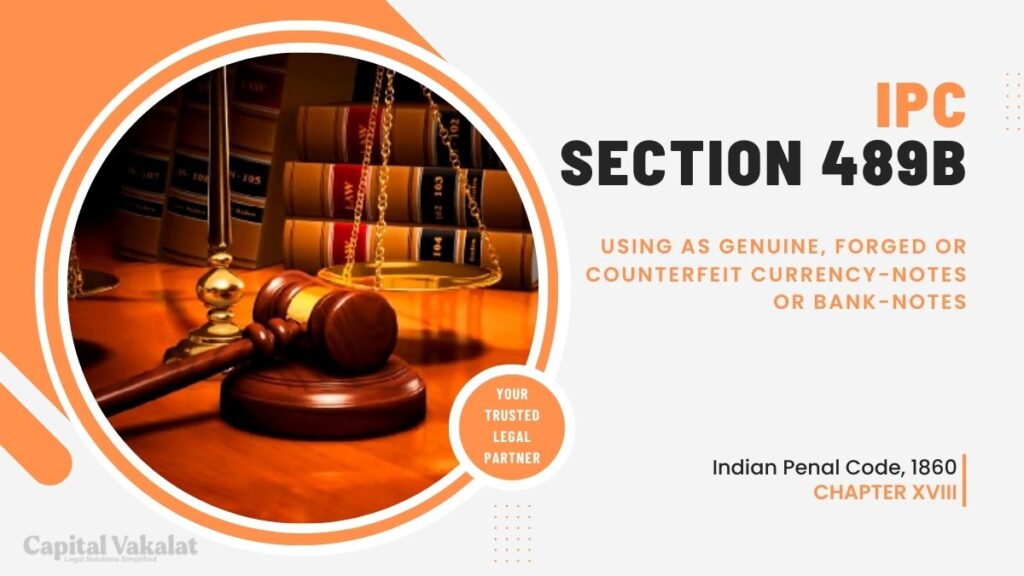Section 489B of the Indian Penal Code (IPC) plays a pivotal role in addressing the misuse of currency-notes, encompassing both genuine and counterfeit banknotes.

This legal provision is designed to curb activities involving the use of forged or counterfeit currency, safeguarding the economic stability of the nation.
Understanding Section 489B IPC
In essence, Section 489B IPC criminalizes the act of using currency-notes or bank-notes that are forged, counterfeit, or not genuine. This encompasses a wide range of monetary instruments, from paper currency to various forms of banknotes issued by financial institutions. The objective is to maintain the integrity of the country’s financial system and protect citizens from economic crimes.
Penalties and Punishments
The repercussions of violating Section 489B are severe. Offenders can face imprisonment and hefty fines, highlighting the gravity of engaging in activities related to fake currency. The legal framework is designed to act as a deterrent, discouraging individuals from participating in such unlawful practices.
Real-Life Cases
Numerous real-life cases underscore the importance of Section 489B in combating currency-related crimes. Instances of individuals attempting to pass off counterfeit money in various transactions have been documented. The legal consequences associated with these cases serve as a deterrent, emphasizing the commitment to maintaining the integrity of the financial system.
Detection and Prevention Measures
To counter the circulation of counterfeit money, authorities have implemented sophisticated techniques for detecting genuine currency. Advanced security features, such as holograms and watermarks, are incorporated into banknotes to make forgery more challenging. Additionally, financial institutions and law enforcement agencies collaborate to enhance preventive measures and swiftly identify counterfeit currency.
Economic Impact
The use of fake currency poses a significant threat to the economy. Counterfeiting undermines the value of legitimate currency, eroding public trust and confidence in financial transactions. Financial institutions continually invest in technologies and strategies to mitigate the economic impact of counterfeit money, protecting the overall stability of the nation’s economy.
Global Perspective
Section 489B is not unique to India, and similar laws exist globally to combat the circulation of counterfeit currency. A comparative analysis of international legal frameworks reveals shared objectives in safeguarding the financial systems of respective countries. Collaborative efforts and information sharing on a global scale contribute to a more robust defense against currency counterfeiting.
Challenges in Enforcement
While Section 489B is a powerful tool in the fight against counterfeit currency, enforcement faces challenges. The dynamic nature
of financial crimes requires continuous adaptation of enforcement strategies. Law enforcement agencies encounter difficulties in tracking and apprehending individuals engaged in these activities. Strengthening cooperation between agencies, updating legislation, and investing in technology are essential steps to enhance enforcement capabilities.
Public Awareness and Education
Creating awareness among the public is crucial in the fight against counterfeit currency. Initiatives aimed at educating citizens about the security features of genuine currency can empower them to identify and report suspicious transactions. Government campaigns and collaborations with non-governmental organizations play a vital role in disseminating information and fostering a collective responsibility for maintaining the integrity of the financial system.
Conclusion
In conclusion, Section 489B IPC serves as a cornerstone in the legal framework aimed at preventing the use of forged or counterfeit currency-notes and bank-notes. The stringent penalties associated with this section act as a deterrent, emphasizing the seriousness of engaging in activities that compromise the integrity of the financial system. Real-life cases, detection and prevention measures, and global perspectives collectively highlight the multifaceted approach required to combat currency counterfeiting.
As technology advances, law enforcement and financial institutions must stay ahead of counterfeiters, continually refining strategies and adopting innovative solutions. Public awareness and education remain integral components in creating a vigilant society that actively contributes to the prevention of financial crimes.
Frequently Asked Questions
What are the common security features in genuine currency to prevent counterfeiting?
Genuine currency incorporates security features such as holograms, watermarks, security threads, and color-shifting inks to deter counterfeiting.
How can individuals protect themselves from unknowingly accepting counterfeit currency?
Individuals can stay vigilant by familiarizing themselves with the security features of genuine currency and verifying banknotes during transactions.
Are there international efforts to combat currency counterfeiting?
Yes, many countries collaborate through international organizations and initiatives to share information and combat the global issue of currency counterfeiting.
What role can the public play in the prevention of counterfeit currency circulation?
The public can contribute by staying informed about security features, reporting suspicious transactions, and participating in awareness campaigns to educate others about the risks associated with counterfeit currency.